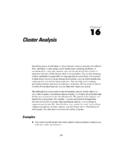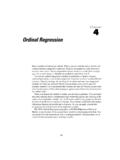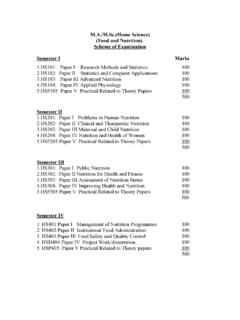Transcription of IBM SPSS Statistics 19 Statistical Procedures Companion
1 375 Chapter17 Cluster AnalysisIdentifying groups of individuals or objects that are similar to each other but different from individuals in other groups can be intellectually satisfying, profitable, or sometimes both. Using your customer base, you may be able to form clusters of customers who have similar buying habits or demographics. You can take advantage of these similarities to target offers to subgroups that are most likely to be receptive to them. Based on scores on psychological inventories, you can cluster patients into subgroups that have similar response patterns. This may help you in targeting appropriate treatment and studying typologies of diseases. By analyzing the mineral contents of excavated materials, you can study their origins and spread. Tip: Although both cluster analysis and discriminant analysis classify objects (or cases) into categories, discriminant analysis requires you to know group membership for the cases used to derive the classification rule.
2 The goal of cluster analysis is to identify the actual groups. For example, if you are interested in distinguishing between several disease groups using discriminant analysis, cases with known diagnoses must be available. Based on these cases, you derive a rule for classifying undiagnosed patients. In cluster analysis, you don t know who or what belongs in which group. You often don t even know the number of groups. Examples You need to identify people with similar patterns of past purchases so that you can tailor your marketing strategies. You ve been assigned to group television shows into homogeneous categories based on viewer characteristics. This can be used for market 17 You want to cluster skulls excavated from archaeological digs into the civilizations from which they originated. Various measurements of the skulls are available. You re trying to examine patients with a diagnosis of depression to determine if distinct subgroups can be identified, based on a symptom checklist and results from psychological a NutshellYou start out with a number of cases and want to subdivide them into homogeneous groups.
3 First, you choose the variables on which you want the groups to be similar. Next, you must decide whether to standardize the variables in some way so that they all contribute equally to the distance or similarity between cases. Finally, you have to decide which clustering procedure to use, based on the number of cases and types of variables that you want to use for forming hierarchical clustering, you choose a statistic that quantifies how far apart (or similar) two cases are. Then you select a method for forming the groups. Because you can have as many clusters as you do cases (not a useful solution!), your last step is to determine how many clusters you need to represent your data. You do this by looking at how similar clusters are when you create additional clusters or collapse existing ones. In k-means clustering, you select the number of clusters you want. The algorithm iteratively estimates the cluster means and assigns each case to the cluster for which its distance to the cluster mean is the smallest.
4 In two-step clustering, to make large problems tractable, in the first step, cases are assigned to preclusters. In the second step, the preclusters are clustered using the hierarchical clustering algorithm. You can specify the number of clusters you want or let the algorithm decide based on preselected term cluster analysis does not identify a particular Statistical method or model, as do discriminant analysis, factor analysis, and regression. You often don t have to make any assumptions about the underlying distribution of the data. Using cluster analysis, you can also form groups of related variables, similar to what you do in factor analysis. There are numerous ways you can sort cases into groups. The choice of a method depends on, among other things, the size of the data file. Methods commonly used for small datasets are impractical for data files with thousands of cases. 377 Cluster AnalysisIBM spss Statistics has three different Procedures that can be used to cluster data: hierarchical cluster analysis, k-means cluster, and two-step cluster.
5 They are all described in this chapter. If you have a large data file (even 1,000 cases is large for clustering) or a mixture of continuous and categorical variables, you should use the IBM spss Statistics two-step procedure. If you have a small dataset and want to easily examine solutions with increasing numbers of clusters, you may want to use hierarchical clustering. If you know how many clusters you want and you have a moderately sized dataset, you can use k-means clustering. You ll cluster three different sets of data using the three IBM spss Statistics Procedures . You ll use a hierarchical algorithm to cluster figure-skating judges in the 2002 Olympic Games. You ll use k-means clustering to study the metal composition of Roman pottery. Finally, you ll cluster the participants in the 2002 General Social Survey, using a two-stage clustering algorithm. You ll find homogenous clusters based on education, age, income, gender, and region of the country.
6 You ll see how Internet use and television viewing varies across the ClusteringThere are numerous ways in which clusters can be formed. Hierarchical clustering is one of the most straightforward methods. It can be either agglomerative or divisive. Agglomerative hierarchical clustering begins with every case being a cluster unto itself. At successive steps, similar clusters are merged. The algorithm ends with everybody in one jolly, but useless, cluster. Divisive clustering starts with everybody in one cluster and ends up with everyone in individual clusters. Obviously, neither the first step nor the last step is a worthwhile solution with either agglomerative clustering, once a cluster is formed, it cannot be split; it can only be combined with other clusters. Agglomerative hierarchical clustering doesn t let cases separate from clusters that they ve joined. Once in a cluster, always in that cluster.
7 To form clusters using a hierarchical cluster analysis, you must select: A criterion for determining similarity or distance between cases A criterion for determining which clusters are merged at successive steps The number of clusters you need to represent your dataTip: There is no right or wrong answer as to how many clusters you need. It depends on what you re going to do with them. To find a good cluster solution, you must look at the characteristics of the clusters at successive steps and decide when you have an interpretable solution or a solution that has a reasonable number of fairly homogeneous 17 Figure Skating Judges: The ExampleAs an example of agglomerative hierarchical clustering, you ll look at the judging of pairs figure skating in the 2002 Olympics. Each of nine judges gave each of 20 pairs of skaters four scores: technical merit and artistry for both the short program and the long program.
8 You ll see which groups of judges assigned similar scores. To make the example more interesting, only the scores of the top four pairs are included. That s where the Olympic scoring controversies were centered. (For background on the controversy concerning the 2002 Olympic Winter Games pairs figure skating, see The actual scores are only one part of an incredibly complex, and not entirely objective, procedure for assigning medals to figure skaters and ice dancers.)*Tip: Consider carefully the variables you will use for establishing clusters. If you don t include variables that are important, your clusters may not be useful. For example, if you are clustering schools and don t include information on the number of students and faculty at each school, size will not be used for establishing Alike (or Different) Are the Cases?Because the goal of this cluster analysis is to form similar groups of figure-skating judges, you have to decide on the criterion to be used for measuring similarity or distance.
9 Distance is a measure of how far apart two objects are, while similarity measures how similar two objects are. For cases that are alike, distance measures are small and similarity measures are large. There are many different definitions of distance and similarity. Some, like the Euclidean distance, are suitable for only continuous variables, while others are suitable for only categorical variables. There are also many specialized measures for binary variables. See the Help system for a description of the more than 30 distance and similarity measures available in IBM spss : The computation for the selected distance measure is based on all of the variables you select. If you have a mixture of nominal and continuous variables, you must use the two-step cluster procedure because none of the distance measures in hierarchical clustering or k-means are suitable for use with both types of variables.* I wish to thank Professor John Hartigan of Yale University for extracting the data from and making it available as a data AnalysisTo see how a simple distance measure is computed, consider the data in Figure 17-1.
10 The table shows the ratings of the French and Canadian judges for the Russian pairs figure skating team of Berezhnaya and 17-1 Distances for two judges for one pairYou see that, for the long program, there is a point difference in technical merit scores and a difference in artistry scores between the French judge and the Canadian judge. For the short program, they assigned the same scores to the pair. This information can be combined into a single index or distance measure in many different ways. One frequently used measure is the squared Euclidean distance, which is the sum of the squared differences over all of the variables. In this example, the squared Euclidean distance is The squared Euclidean distance suffers from the disadvantage that it depends on the units of measurement for the variables. Standardizing the VariablesIf variables are measured on different scales, variables with large values contribute more to the distance measure than variables with small values.





